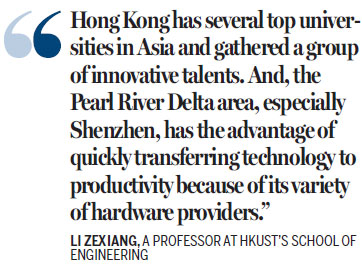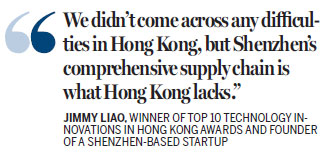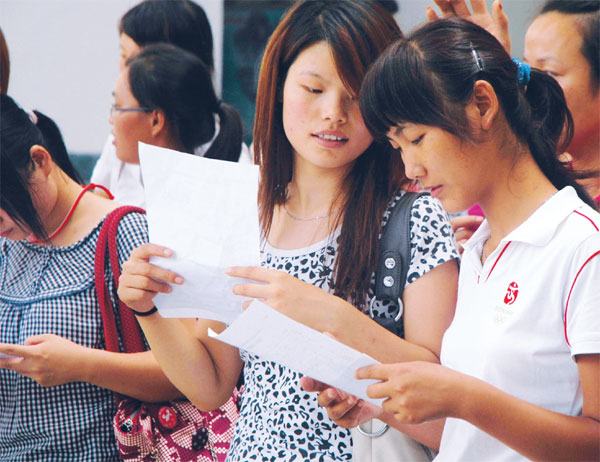On the legendary trail
Updated: 2015-01-06 05:30
By Chai Hua(HK Edition)
|
|||||||
More young entrepreneurs are setting up shop in Shenzhen because the city excels in research and technology transfers, as Chai Hua reports from Shenzhen.
DJI Technologies has become a startup legend for many young entrepreneurs.
DJI founder Wang Tao is a graduate of the Hong Kong University of Science and Technology (HKUST), but chose to start his career across the border in Shenzhen.
Following his steps, Jimmy Liao, whose works once won the Top 10 Technology Innovations in Hong Kong awards, also moved his startup to Shenzhen this year.
Another young entrepreneur, Ricky Leung decided to pursue his dream which has so far attracted two Hong Kong investors in Shenzhen.

More and more young entrepreneurs, especially in the innovative technology field, formed an innovative idea or established an early-stage startup in Hong Kong, but have chosen to move out for further development.
According to statistics by Monsterbees, a consulting company providing services for Hong Kong returnees and residents who intend to work on the mainland, the number of its clients has risen tenfold since 2011.
Felix Chen, the company's chief consultant, told China Daily: "On Hong Kong returnees alone, we have about 10,500 cases and half of them come to Shenzhen to set up their startups."
These entrepreneurs have brought more than 300 new enterprises to Shenzhen. Above 70 percent focus on technology innovation, including new energy, new material, e-marketing and medical equipment.
Most of the young entrepreneurs have achieved some success in Hong Kong, so it's not that they escaped to Shenzhen to avoid troubles back home. They are not in Shenzhen for the cheap rents or low working spending either.
The HKSAR government has been increasing support for startups in recent years.
The HKSAR government-owned Cyberport, a digital community located on southern Hong Kong Island, has been aggressive in roping startups with promise, such as low office rent, financial assistance and professional guidance.
Ricky Leung's team once joined a Cyberport funding program, as well as Startup Weekend, whose mission is to kick-start and foster startup communities worldwide through events and networking sessions.
"In Hong Kong, there's entrepreneurial training provided by Startup Weekend, Cyberport, Hong Kong Science and Technology Parks, and various startup courses held by universities," he noted.
So why did they leave Hong Kong - a much developed and internationalized metropolis than Shenzhen?
"We didn't come across any difficulties in Hong Kong," said Liao, "but Shenzhen's comprehensive supply chain is what Hong Kong lacks".
The key product of Liao's startup is "Chefbot" - a combination of kitchen scale, cooking timer, recipe reader and Bluetooth speaker.
Liao has accumulated years of experience in project development through working with Nokia and Apple, whose technology operation model has had a deep influence on him.

"Most of my suppliers are in Shenzhen, which I got to know from my previous work contacts or friends," he added.
Ricky Leung agreed: "Since Hong Kong has very few manufacturers and factories, both in number and variety, compared with the Chinese mainland, it's difficult to have a hardware supply chain setup in Hong Kong due to the very limited choices and higher operating costs compared with the mainland."
Within 1.5 hours' driving distance from Huaqiang north is one of the most vitality manufacture chains in the world involved in electronic components, industrial design to factory processing.
Shenzhen also has many companies helping hardware startups to make their very first production. Seeed Studio is one of them.
The studio provides an open environment for entrepreneurs to communicate and realize ideas for production with basic model development equipments, such as 3D printer, laser cuter, electronic development equipment and equipment processor.
The studio also has a small factory for small orders, which most factories may not accept. When a single order exceeds 10,000, they will introduce the startup to traditional OEMs (original equipment manufacturers). The transition is a matter of life and death for nascent and early-stage startups.
Foxconn, the world's largest contract electronics manufacturer, set up a factory called Innoconn, which is dedicated to innovative startup projects in Shenzhen.
Recently, the mainland released the first research report on regional incubation capability, evaluating 20 incubating zones in China, in which Shenzhen has the most selected zones. Moreover, Shenzhen's Nanshan district has nine State-level technology incubators rated as the best of innovative incubation zones.
On the contrary, Hong Kong dropped from last year's 23rd to 26th position in innovation rankings in this year's The Global Competitiveness Report.
The Global Entrepreneurship Monitor (GEM) research program, an annual assessment of the national level of entrepreneurial activity, made a comparison between Shenzhen and Hong Kong, finding that Shenzhen, or other regions on the mainland, have better results of research and development transfer.
GEM experts suggested that Hong Kong universities strengthen cooperation with enterprises, and research funds should be linked up with their commercial viability.
Li Zexiang, a professor at HKUST's School of Engineering, realized the need and created a new course model connecting course design, graduation project and innovation.
At one of his courses for robot competition, he taught his students to design robots together and went to Shenzhen to purchase accessories and produce to let students learn about the city's complete production chain.
That's the course that has helped Wang Tao and many of his classmates start their own startups in Shenzhen.
Li admitted that Shenzhen has plenty of resources, but what it lacks is the most fundamental element - world class research universities, which Hong Kong has.
"Hong Kong has several top universities in Asia and gathered a group of innovative talents," Li said. "And, the Pearl River Delta area, especially Shenzhen, has the advantage of quickly transferring technology to productivity because of its variety of hardware providers."
"Hong Kong's higher education, our most precious resources, will have endless potential if it combines with the industry system in the Pearl River Delta region," Li said.
Contact the writer at grace@chinadailyhk.com
|
Hong Kong's innovative talent pool would shed new light on the city's development, once combined with the industry in the Pearl River Delta region. Asia News Photo |
(HK Edition 01/06/2015 page9)
